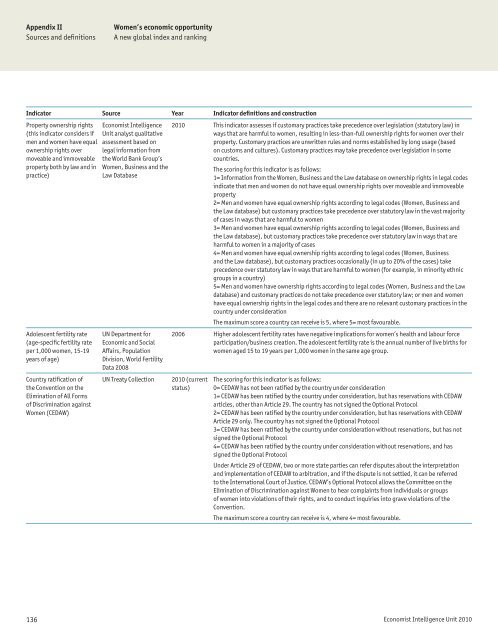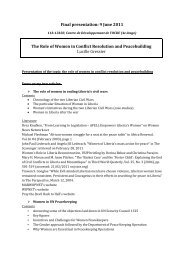Women's Economic Opportunity Index - Economist Intelligence Unit
Women's Economic Opportunity Index - Economist Intelligence Unit
Women's Economic Opportunity Index - Economist Intelligence Unit
- No tags were found...
Create successful ePaper yourself
Turn your PDF publications into a flip-book with our unique Google optimized e-Paper software.
Appendix IISources and definitionsWomen’s economic opportunityA new global index and rankingIndicator Source Year Indicator definitions and constructionProperty ownership rights(this indicator considers ifmen and women have equalownership rights overmoveable and immoveableproperty both by law and inpractice)Adolescent fertility rate(age-specific fertility rateper 1,000 women, 15-19years of age)Country ratification ofthe Convention on theElimination of All Formsof Discrimination againstWomen (CEDAW)<strong>Economist</strong> <strong>Intelligence</strong><strong>Unit</strong> analyst qualitativeassessment based onlegal information fromthe World Bank Group’sWomen, Business and theLaw DatabaseUN Department for<strong>Economic</strong> and SocialAffairs, PopulationDivision, World FertilityData 2008UN Treaty Collection2010 This indicator assesses if customary practices take precedence over legislation (statutory law) inways that are harmful to women, resulting in less-than-full ownership rights for women over theirproperty. Customary practices are unwritten rules and norms established by long usage (basedon customs and cultures). Customary practices may take precedence over legislation in somecountries.The scoring for this indicator is as follows:1= Information from the Women, Business and the Law database on ownership rights in legal codesindicate that men and women do not have equal ownership rights over moveable and immoveableproperty2= Men and women have equal ownership rights according to legal codes (Women, Business andthe Law database) but customary practices take precedence over statutory law in the vast majorityof cases in ways that are harmful to women3= Men and women have equal ownership rights according to legal codes (Women, Business andthe Law database), but customary practices take precedence over statutory law in ways that areharmful to women in a majority of cases4= Men and women have equal ownership rights according to legal codes (Women, Businessand the Law database), but customary practices occasionally (in up to 20% of the cases) takeprecedence over statutory law in ways that are harmful to women (for example, in minority ethnicgroups in a country)5= Men and women have ownership rights according to legal codes (Women, Business and the Lawdatabase) and customary practices do not take precedence over statutory law; or men and womenhave equal ownership rights in the legal codes and there are no relevant customary practices in thecountry under considerationThe maximum score a country can receive is 5, where 5= most favourable.2006 Higher adolescent fertility rates have negative implications for women’s health and labour forceparticipation/business creation. The adolescent fertility rate is the annual number of live births forwomen aged 15 to 19 years per 1,000 women in the same age group.2010 (currentstatus)The scoring for this indicator is as follows:0= CEDAW has not been ratified by the country under consideration1= CEDAW has been ratified by the country under consideration, but has reservations with CEDAWarticles, other than Article 29. The country has not signed the Optional Protocol2= CEDAW has been ratified by the country under consideration, but has reservations with CEDAWArticle 29 only. The country has not signed the Optional Protocol3= CEDAW has been ratified by the country under consideration without reservations, but has notsigned the Optional Protocol4= CEDAW has been ratified by the country under consideration without reservations, and hassigned the Optional ProtocolUnder Article 29 of CEDAW, two or more state parties can refer disputes about the interpretationand implementation of CEDAW to arbitration, and if the dispute is not settled, it can be referredto the International Court of Justice. CEDAW’s Optional Protocol allows the Committee on theElimination of Discrimination against Women to hear complaints from individuals or groupsof women into violations of their rights, and to conduct inquiries into grave violations of theConvention.The maximum score a country can receive is 4, where 4= most favourable.136 <strong>Economist</strong> <strong>Intelligence</strong> <strong>Unit</strong> 2010




